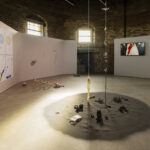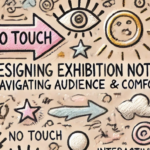In today’s tutorial, I received a lot of valuable feedback that helped me further clarify the direction of the curatorial project. One of the key suggestions was to abandon the use of AR as a form of presentation and to think deeply about the ‘why’ of using a certain medium. Instead of using technology for the sake of technology, we should go back to the essence of curation – the meaning behind each means of presentation.
I told my mentor, JL, that I had recently given up the idea of using AR technology. On the one hand, due to financial constraints, it is difficult for me to provide every visitor with a device such as an iPad, and if I switch to scanning, I have to rely on visitors to bring their own mobile phones. However, when I spoke to a friend of mine who is a digital media student at UAL last weekend, she said she didn’t like the experience of having to use her mobile phone to scan a code to get to the page. This got me to reflecting:If I were the audience, would I really like this approach? The answer is no – this type of interaction tends to interrupt immersion and also seems redundant and cumbersome.
I realised that interaction should not be ‘for the sake of interaction’. I realised that interaction should not be ‘interaction for interaction’s sake’, but that the audience’s experience and feelings are the most important part of my curatorial work. JL agreed with my idea and pointed out one thing that impressed me: the moment the audience took out their mobile phones, their attention entered the world of mobile phones rather than the exhibition space itself. This inspired me – I wanted the viewer’s body and senses to remain in the space, rather than escaping beyond the screen.
Of course, I will still be sorting out and analysing the advantages and disadvantages of using AR technology as part of my research, as it is an important curatorial judgement to be clear about the reasons for ‘not using’ it.
JL also reminded me of the need to set up a clear ‘warning’ at the entrance of the exhibition. This is because some of the works in my exhibition and the misty space may cause discomfort to certain groups of people (e.g. claustrophobic viewers, or children). Therefore, it is necessary to post a warm warning at the entrance to inform the audience in advance of the possible physical and psychological experience.
At the end of the tutorial, we also discussed the issue of budget and schedule. I had invited several students from the Chinese Academy of Fine Arts to participate in my exhibition, and the works would be transported from China to Edinburgh, so I needed to draw up a preliminary transport budget covering shipping, customs, insurance, etc. Although most of the works were not particularly bulky, they would need to be transported from China to Edinburgh, and I would have to pay for them in advance. Whilst most of the works are not particularly large, the potential costs still need to be reasonably assessed to ensure enforceability.
In addition, I will also begin to draft a timeline for the production of the exhibition, including material preparation, set-up, and testing. Given the immersive and interactive nature of some of the installations in the exhibition, it is expected that at least three days of set-up time will be required to complete the overall space.





